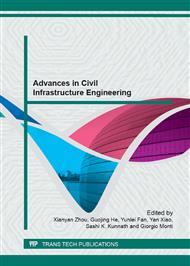p.708
p.714
p.721
p.727
p.732
p.740
p.745
p.752
p.757
Experimental Investigation of Seismic Behavior of a New Type Masonry Walls
Abstract:
Conventional concrete hollow blocks have vertical single or multiple holes and they have been extensively used in masonry structures and as infill walls in reinforced concrete frame structures. However, most masonry walls using conventional concrete hollow blocks have the shortcoming of poor seismic resistance. A new type concrete hollow block with horizontal-holes has been developed and it could significantly improve the seismic resistance of a masonry wall as well as simplify the construction processes. The new hollow blocks are very easy to build a wall in a construction site and, in particular, they enable a convenient construction of reinforced concrete (RC) horizontal strips in their horizontal cavities and such RC strips can be readily connected to the adjacent RC columns. This provides an innovative seismic resistant measure to enhance the seismic resistance of masonry walls. In order to evaluate the seismic behavior of the new type masonry walls, an experimental investigation was carried out and seven full scale wall specimens were tested under in-plane cyclic loading. The experimental parameters include the number of horizontal RC strips, strength of the hollow blocks, height/width ratio of a wall and, with or without a window opening in the wall. In this paper, the details of the experimental investigation and the main test results are presented and, the characteristics of the seismic behavior of these wall specimens are discussed in relation to the influence of the experimental parameters.
Info:
Periodical:
Pages:
732-739
Citation:
Online since:
January 2013
Authors:
Price:
Сopyright:
© 2013 Trans Tech Publications Ltd. All Rights Reserved
Share:
Citation:


